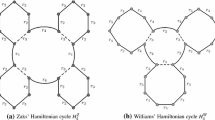Abstract
We show three main results concerning Hamiltonicity of graphs derived from antimatroids. These results provide Gray codes for the feasible sets and basic words of antimatroids.
For antimatroid (E,\(\mathcal{F}\)), letJ(\(\mathcal{F}\)) denote the graph whose vertices are the sets of\(\mathcal{F}\), where two vertices are adjacent if the corresponding sets differ by one element. DefineJ(\(\mathcal{F}\);k) to be the subgraph ofJ(\(\mathcal{F}\))2 induced by the sets in\(\mathcal{F}\) with exactlyk elements. Both graphsJ(\(\mathcal{F}\)) andJ(\(\mathcal{F}\);k) are connected, and the former is bipartite.
We show that there is a Hamiltonian cycle inJ(\(\mathcal{F}\))×K 2. As a consequence, the ideals of any poset % MathType!MTEF!2!1!+-% feaafiart1ev1aaatCvAUfeBSjuyZL2yd9gzLbvyNv2CaerbuLwBLn% hiov2DGi1BTfMBaeXatLxBI9gBaerbd9wDYLwzYbItLDharqqtubsr% 4rNCHbGeaGqiVu0Je9sqqrpepC0xbbL8F4rqqrFfpeea0xe9Lq-Jc9% vqaqpepm0xbba9pwe9Q8fs0-yqaqpepae9pg0FirpepeKkFr0xfr-x% fr-xb9adbaqaaeGaciGaaiaabeqaamaabaabaaGcbaWefv3ySLgznf% gDOfdaryqr1ngBPrginfgDObYtUvgaiuaacqWFpepuaaa!414C!\[\mathcal{P}\] may be listed in such a way that successive ideals differ by at most two elements. We also show thatJ(\(\mathcal{F}\);k) has a Hamilton path if (E,\(\mathcal{F}\)) is the poset antimatroid of a series-parallel poset.
Similarly, we show thatG(\(\mathcal{L}\))×K 2 is Hamiltonian, whereG(\(\mathcal{L}\)) is the “basic word graph” of a language antimatroid (E,\(\mathcal{L}\)). This result was known previously for poset antimatroids.
Similar content being viewed by others
References
M. O. Ball and J. S. Provan (1983) Calculating bounds on reachability and connectedness in stochastic networks,Networks 13, 253–278.
J. Bitner, G. Ehrlich, and E. Reingold (1976) Efficient generation of the binary reflected Gray code and its applications,Communications of the ACM 19, 517–521.
T. Beyer and F. Ruskey (1989) Constant average time generation of subtrees of bounded size, unpublished manuscript.
A. Björner and G. M. Ziegler (1992) Introduction to greedoids, inMatroid Applications (ed. N. White), Cambridge University Press.
G. Ehrlich (1973) Loopless algorithms for generating permutations, combinations, and other combinatorial configurations,JACM 20, 500–513.
G. Hurlbert (1993) The antipodal layers problem,Discrete Math., to appear.
J. T. Joichi, D. E. White, and S. G. Willamson (1980) Combinatorial Gray codes,SIAM J. Computing 9, 130–141.
H. A. Kierstead and W. T. Trotter (1988) Explicit matchings in the middle levels of the Boolean lattice,Order 5, 163–71.
Y. Koda and F. Ruskey (1993) A Gray code for the ideals of a forest poset,J. Algorithms 15, 324–340.
B. Korte and L. Lovasz (1985) Basis graphs of greedoids and two-connectivity,Mathematical Programming Study 24, 158–165.
B. Korte, L. Lovasz, and R. Schrader (1991)Greedoids, Springer-Verlag.
E. L. Lawler (1979) Efficient implementation of dynamic programming algorithms for sequencing problems, Report BW106/79, Stichting Mathematisch Centrum, Amsterdam, 1979.
J. Propp (1992) Partial ordering for matchings of bipartite planar graphs, 23rd S.E. Intl. Conference on Combinatorics, Graph Theory and Computing.
G. Pruesse (1991) Generating linear extensions of series-parallel posets by transpositions, manuscript.
G. Pruesse and F. Ruskey (1991) Generating the linear extensions of certain posets by transpositions,SIAM J. Discrete Math. 4, 413–422.
G. Pruesse and F. Ruskey (1993) Generating linear extensions fast, to appear inSIAM J. Computing, to appear.
E. M. Reingold, J. Nievergelt, and N. Deo (1977)Combinatorial Algorithms: Theory and Practice, Prentice Hall.
F. Ruskey (1992) Generating linear extensions of posets by transpositions,J. Combinatorial Theory (B)54, 77–101.
F. Ruskey (1988) Research Problem 90,Discrete Math. 70, 111–112.
L. Schrage and K. R. Baker (1978) Dynamic programming solution for sequencing problems with precedence constraints,Operations Research 26, 444–449.
G. Stachowiak (1992) Hamilton paths in graphs of linear extensions for unions of posets,SIAM J. Discrete Math. 5, 199–206.
G. Steiner (1986) An algorithm to generate the ideals of a partial order,Operations Research Letters 5, 317–320.
F. Ruskey (1981) Listing and counting subtrees of a tree,SIAM J. Computing 10, 141–150.
F. Ruskey (1992) Generating linear extensions of posets,J. Combinatorial Theory (B)54, 77–101.
R. P. Stanley (1986)Enumerative Combinatorics, Vol. I, Wadsworth.
H. S. Wilf (1989)Combinatorial Algorithms: An Update, SIAM, CBMS 55.
G. M. Ziegler (1988) Branchings in rooted graphs and the diameter of greedoids,Combinatorica 8, 217–234.
Author information
Authors and Affiliations
Additional information
Communicated by N. Zaguia
Research supported in part by NSERC.
Research supported in part by the Natural Sciences and Engineering Research Council of Canada under Grant A3379.
Rights and permissions
About this article
Cite this article
Pruesse, G., Ruskey, F. Gray codes from antimatroids. Order 10, 239–252 (1993). https://doi.org/10.1007/BF01110545
Received:
Accepted:
Issue Date:
DOI: https://doi.org/10.1007/BF01110545




